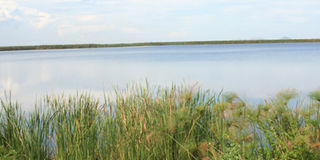Tragedy unfolding in Siaya after lake breaks dykes and flows to farmland

Lake Kanyaboli which is in the Yala swamp. Already, the lake has lost more than 50 percent of its volume.
An environmental disaster is shaping up in Siaya County. Kanyaboli, an ox-bow lake in Siaya, is losing its water at an alarming rate after it broke all its dykes and water is now flowing downstream.
The lake is sweeping away anything on its path, and residents have lost homes and crops.
Already, the lake has lost more than 50 percent of its volume, and if urgent action is not taken, communities that rely on it for livelihood would be adversely affected.
Lake Kanyaboli is the second largest ox-bow lake in Africa, formed after River Yala disconnected from its course at the meander stage, leaving behind a U-shaped Lake.
The water, which has been draining from the lake for the past one week, is flowing towards the lower part of Yala swamp.
Yala Farmers Association Chairman Fredrick Okumu said Lake Kanyaboli could soon cease to exist.
“It is sad that this lake will be history if nothing is done. Currently, children are picking fish from the mud left behind. Water is flowing down towards the farms at a very high rate,” he said.
Farmers cultivating the reclaimed fields on the southern part of Yala swamp are also counting losses after the water swept away their crops.
“We have lost everything. We are calling upon the government to at least compensate us for the seeds and the cost of cultivation because we have lost everything as a result of this unfortunate occurrence,” said Mr Okumu.
Some of the houses built on the lower part of the swamp were also swept away.
Mr Michael Opat, 39, a fisherman, told Nation that more than 300 fishermen have been affected directly and face a bleak future with the lake slowly disappearing.
“From the time of my forefathers when the lake had plenty of fish, this has been a source of my livelihood. I feed and educate my children from the proceeds from this lake. It pains me to see only mud left behind,” he complained.
He further reported that for one week, they have parked their fishing vessels, waiting for the government to act.
“We reported this to our local leaders and nothing has happened. One of the local leaders visited and just took selfies where the dyke was broken and then drove away. This is killing our hopes as the people who depend on this lake directly,” he added.
Mr Chris Owala, the director of Community Initiative Action Group (CIAG) in Siaya, blames the government for failing to take action when a former investor who obtained a lease of Yala swamp for 25 years allegedly interfered with the lake.
“Lake Kanyaboli might disappear like the famous Lake Chad. This is because the government cares very little about concerns raised by the community,” said Mr Owala, who has been leading campaigns against environmental degradation in Yala swamp.
“The first investor divided the lake into two parts, and he reclaimed the lower part and left the upper part. We complained because this was a disaster waiting to happen. Today, water broke the dyke and began flowing downwards destroying everything on its way,” said Mr Owala.
He faults the government agencies such as the National Environment Management Authority (Nema) and the Water Resource Authority (WRA) for failing to act when the damage was done.
“We complained, not once, we wrote letters to the agencies to act because other than being a resource where the community earned their living as fishermen, it was a tourist attraction that brought both local and foreign tourists,” complained Mr Owala.
However, according to environmentalist William Arunga, the flow of water from Lake Kanyaboli was expected.
“For a long time, after reclamation, the lake did not have both inlet and outlet. As a result, there was continual erosion of the dyke, which people and the government did not pay attention to. When the dyke was completely eroded, water found its way out following the original river valley that existed at the time of its formation,” he explained.
Lake Kanyaboli gets 90 per cent of its water from rain, however it has no outlet to offload the water during the rainy seasons.
Former Central Alego MCA Leonard Oriaro, however, believes that prompt action could save the lake from vanishing.
“We urgently need gabions around the dyke that was broken in order to contain further outflow of water. Secondly, the lake needs an outlet, the National Youth Service (NYS) brought an excavator that would be used to create an outlet; however, it stopped on the way due to lack of fuel. That is the only remedy,” he said.
The imminent disappearance of the lake, other than affecting the community, will also upset institutions such as schools and homesteads that depend on it as a source of water.
Lake Kanyaboli forms part of the ecosystem that comprises Yala Swamp, and two satellite lakes — Lake Namboyo and Lake Sare — which are known as the jewels of Yala.
The Yala swamp is leased to Lake Agro Limited for 60 years at a cost of Sh60 billion.





